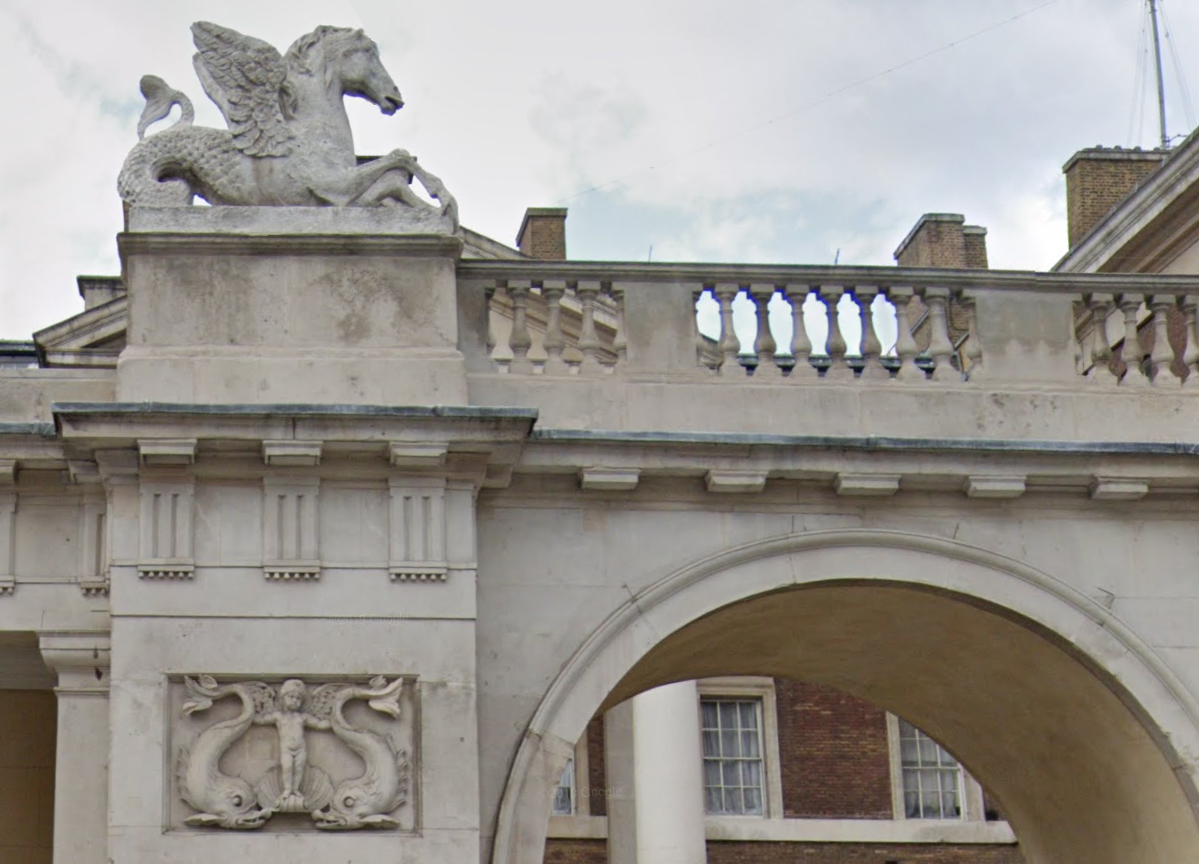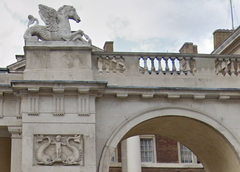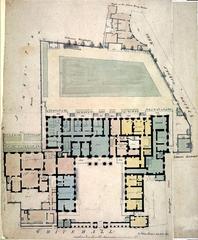
Admiralty Buildings London: Visiting Hours, Tickets, and Historical Sites Guide
Date: 14/06/2025
Introduction
The Admiralty Buildings in London are a series of landmark structures that embody the United Kingdom’s naval heritage and architectural splendor. Strategically located between Trafalgar Square and Buckingham Palace, this historic complex includes Admiralty Arch, the Ripley Building, Admiralty House, and the Old Admiralty Building. Their evolution mirrors Britain’s rise as a global maritime power, while their continued adaptation reflects the city’s dynamic spirit (Wikipedia; EssentialLDN).
This comprehensive guide explores the historical development, architectural significance, modern transformations, and practical visitor information for the Admiralty Buildings. Whether you are a history enthusiast, architecture lover, or traveler planning your London itinerary, this article will help you understand and experience one of the city’s most storied districts.
Historical Overview
Early Origins and Naval Ascendancy
The Admiralty’s beginnings date to the early 18th century with the construction of the Ripley Building in 1726. Designed by Thomas Ripley, it stands as one of Britain’s earliest purpose-built government offices. While its exterior is relatively austere, its role was crucial—serving as the administrative hub for the Royal Navy during a period of expanding British influence. The building’s prominence is highlighted by events such as Admiral Lord Nelson’s body lying in state there in 1806.
Expansion and the Age of Empire
The Admiralty complex grew with the addition of Admiralty House in 1788, providing a residence for the First Lord of the Admiralty. The Old Admiralty Building, or Admiralty Extension, completed by 1907, reflects Queen Anne Revival architecture and was constructed to accommodate the rapidly growing naval administration during the prelude to World War I.
Twentieth Century Transformations
Admiralty Arch, completed in 1912, serves as a ceremonial gateway between Trafalgar Square and The Mall, leading to Buckingham Palace. Built as a memorial to Queen Victoria, it became synonymous with royal and state occasions. During World War II, the imposing Admiralty Citadel was constructed for secure naval operations. Over the years, the complex has adapted to governmental and ceremonial needs, with several buildings retaining active administrative functions (Willmott Dixon).
Architectural and Cultural Significance
Admiralty Arch: Edwardian Monumentality
Admiralty Arch is a masterpiece of Edwardian grandeur, designed by Sir Aston Webb. Its imposing Portland stone façade features five arches: a central arch for royal processions and two side arches for vehicles and pedestrians. Lavish decorative features, including Latin inscriptions and royal armorials, reinforce its ceremonial role and imperial symbolism (EssentialLDN; Medium).
A quirky detail is the “Secret Nose”—a small sculpture installed in 1996 by artist Rick Buckley as a satirical statement, now a local curiosity (World History Edu).
The Ripley Building and Admiralty House: Georgian and Regency Refined
The Ripley Building, with its understated classicism and later Adam-designed screen, represents early Georgian government architecture. Admiralty House, built in the 1780s, is a discreet Regency mansion facing Horse Guards Parade, notable for its historic residents, including Winston Churchill.
Admiralty Extension and Citadel: Revival and Wartime Utility
The Old Admiralty Building’s Queen Anne Revival style, marked by its “streaky bacon” red brick and Portland stone, reflects early 20th-century tastes and Britain’s growing naval power. The Admiralty Citadel, built in 1940 with fortress-like concrete, stands as a stark example of wartime brutalism (EssentialLDN).
Ceremonial and Cultural Role
Admiralty Arch is the ceremonial gateway for royal processions, including coronations and national celebrations, anchoring The Mall’s processional route. The buildings also played a role in naval intelligence, with figures such as Ian Fleming (creator of James Bond) serving here during WWII (Medium).
Modern Usage and Renovations
Admiralty Arch: From State Gateway to Luxury Hotel
Admiralty Arch’s transformation into the Waldorf Astoria London Admiralty Arch marks a new chapter. The 96-room hotel, scheduled to open in 2025, will offer public access to some interiors, a rooftop bar, spa, and private residences. The restoration, led by Hilton and the Reuben Brothers, ensures preservation of historic features while integrating 21st-century amenities (Hotel News Resource; ScaffMag; Reuben Brothers).
Careful restoration includes façade preservation, advanced infrastructure, and innovative construction solutions to support the complex renovation (Specification Online).
Old Admiralty Building: Government Hub Revitalized
The Old Admiralty Building has undergone a £60 million refurbishment, blending modern office space with restored historic interiors. It houses the Department for International Trade and accommodates up to 2,400 government staff. Notable rooms linked to Winston Churchill and Ian Fleming have been carefully preserved (Willmott Dixon; Digital Trade Blog).
Visiting the Admiralty Buildings
Visiting Hours and Tickets
- Admiralty Arch Exterior: Open to the public 24/7.
- Interior Access: Will be available to hotel guests and possibly through limited guided tours after the Waldorf Astoria opens in 2025 (Admiralty Arch official site).
- Old Admiralty Building: Active government offices; public entry not permitted.
No tickets are required to view exteriors. Interior access, when available, will likely require hotel reservations or pre-booked tours.
Accessibility
Public spaces around Admiralty Arch and Whitehall are wheelchair accessible. The hotel is expected to offer full accessibility upon completion. Check official sources for the latest information during ongoing construction.
Guided Tours and Special Events
Several London walking tours include the Admiralty Buildings and Whitehall’s landmarks. Special state occasions and royal events are visible from public areas around Admiralty Arch.
Nearby Attractions
Within easy walking distance:
- Trafalgar Square: National Gallery, Nelson’s Column.
- The Mall: Ceremonial avenue to Buckingham Palace.
- St James’s Park: Scenic gardens and wildlife.
- Horse Guards Parade: Changing of the Guard.
- The Cabinet War Rooms: Churchill’s WWII command center.
Nearby dining includes The Admiralty (nautical-themed British pub) and Walkers of Whitehall.
Travel Tips
- Transport: Charing Cross and Embankment Underground stations are closest. Numerous bus routes serve the area.
- Best Photos: Capture Admiralty Arch from Trafalgar Square or The Mall, especially in morning or late afternoon light.
- Weather: Bring an umbrella; much of the site is outdoors.
Frequently Asked Questions (FAQ)
Q: Can I enter Admiralty Arch?
A: Interior access will be available to hotel guests and possibly via guided tours from 2025. Exteriors are open now.
Q: Is there an entry fee?
A: No fee to view exteriors. Hotel stays and possible tours will require reservations.
Q: Are guided tours available?
A: Walking tours of Whitehall include exteriors. Check with local providers for updates.
Q: Is the area accessible?
A: Yes, public paths are wheelchair accessible.
Q: Can I visit the Old Admiralty Building?
A: No, it is a working government office. The façade can be viewed from Whitehall.
Visual Media
- Images:
- Admiralty Arch’s façade (alt: “Admiralty Arch London entrance with Edwardian architecture”)
- Old Admiralty Building (alt: “Old Admiralty Building Whitehall London”)
- Detail of Latin inscription and the “Secret Nose”
- Maps:
Summary and Visitor Tips
The Admiralty Buildings are pillars of London’s ceremonial and architectural landscape, embodying centuries of naval power and urban grandeur. While interior access is limited until redevelopment is complete, the exteriors and surrounding sites offer a rich experience for visitors. Combine your visit with nearby landmarks to enjoy London’s historic heart. For updates on access, tickets, and special events, check official resources and consider downloading the Audiala app for guided tours and live information.
References and Further Reading
- Wikipedia: Admiralty Buildings
- EssentialLDN: The Architecture of British Naval Power
- Reuben Brothers: Admiralty Arch Redevelopment
- likelovelondon.com: Things to Do in Trafalgar Square, London
- Hotel News Resource: Admiralty Arch Redevelopment
- ScaffMag: London’s Admiralty Arch Gets a Digital Facelift
- Willmott Dixon: Old Admiralty Building Refurbishment
- Daily Mail: Admiralty Arch Transformation
- Medium: Admiralty Arch, an Iconic Historical Landmark in London
Images and maps should include descriptive alt text for accessibility and SEO, such as “Admiralty Arch London entrance with Edwardian architecture” and “Map showing Admiralty Buildings near Trafalgar Square”.





















































































































































































































































